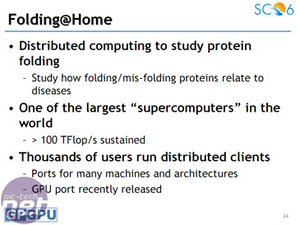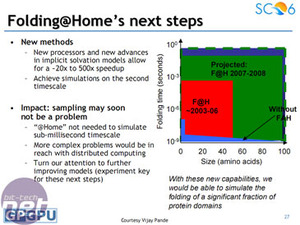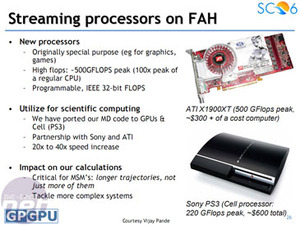Folding@Home



Mike Houston at Stanford University has just worked on porting Folding@Home to the GPU. While Sony's PlayStation 3 is providing some excellent results from the Cell processors, the GPU is leagues above it when it comes to the amount of data crunched in an average day. The problem is that consumers are more inclined to leave their PS3s running overnight or while they are at school/work, but generally they don’t leave their PCs on when they're not being used.
Physics
Both AMD and Nvidia have been touting GPU Physics for some time now and both companies will use the forthcoming Havok FX engine. According to AMD, we'll see the first implementation of Havok FX this summer in a “massively anticipated title” (write your answers on a postcard and send them to... errr -- Ed).Whilst there’s a maximum of one to two thousand colliding objects using CPU accelerated physics (not forgetting all the other stuff like AI and general data processing they have to do in a game) a GPU can handle tens of thousands of objects. The very nature of many objects interacting independently or with each other suits GPUs perfectly as they churn through those thousands of floating point calculations in parallel.
Typical physics algorithms include particle systems, along with fluid, cloth and soft body simulations. By comparison, hard body physics are more difficult to manage as the environment has arbitrary shapes, interactions and dependencies outlining the scene. Finally, the benefit of that third PCI-Express x16 port is realised, as you relegate your old graphics card to physics duties while upgrading to the latest and greatest from AMD or Nvidia.
You will be able to run the physics calculations on a single GPU too, but it will decrease your 3D performance as the game tries to use one card for both tasks. However, if you have a DirectX 9.0c (Shader Model 3.0) card or above then you already have a graphics processor capable of handling next generation physics calculations.
Closing Words...
In all, for the time being GPGPUs are the future as more and more programs are written to use their processing potential. Whilst we won’t explicitly see the 80-core Terascale chip in any of our homes, we will likely see elements of its research in future products. The technologies we're expecting Intel to port over to its future products include chip stacking, inbuilt routers and optical interconnects. Despite how far we’ve come, it’s always humbling to realise computation still has a long way to go.
MSI MPG Velox 100R Chassis Review
October 14 2021 | 15:04










Want to comment? Please log in.